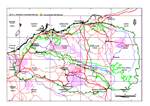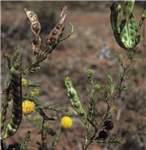Click on images
to enlarge



Photographer: B.R. Maslin

Photographer: J. Simmons

Photographer: K.F. Kenneally
, KFK 9326, FM_sml.jpg)
Seed from one herbarium voucher. Scale in mm. Photographer: F. McCallum
Botanical name
Acacia adoxa var. subglabra Pedley, Contr. Queensland Herb. 11: 7 (1972)
Description
Dense, spreading, procumbent, multi-stemmed shrubs commonly 20-50 cm tall and up to about 1.2 m across, seemingly reaching 1-1.5 m tall in places outside the Pilbara, often straggly with somewhat wiry, entangled branches. Branchlets glabrous or sparsely to moderately short-pilose (the hairs weak, sub-straight to curved and wide-spreading to slightly retrorse). Phyllodes arranged in whorls of 6–10 phyllodes, often appearing very slender, ±terete to flattened, 3-5 mm long (but reaching 12 mm outside the Pilbara), 0.3-0.5 mm wide, ascending to erect, straight or very shallowly incurved and normally slightly recurved at apex, dark green or greyish mid-green, glabrous or with a sprinkling of short, spreading, weak hairs; indistinctly 1-nerved below; abruptly constricted at apex into a short, distinct, non-spiny point. Inflorescences simple; peduncles 6-15 (-23) mm long, glabrous or with hairs similar to those on branchlets; heads globular, 7-8 mm in diameter when fresh, bright yellow, (20-) 25-40-flowered. Flowers 5-merous; calyx dissected into narrowly triangular or linear lobes; petals striate (observe at x10 magnification or higher), glabrous or sparsely hairy. Pods often present at the same time as the flowers, narrowly oblong, flat but rounded over seeds along midline, not constricted between seeds, 2.5-6 cm long, 6-8 mm wide, ±sessile or with a very short stalk about 2 mm long, splitting first along one edge, straight to shallowly curved, sticky, glabrous, light brown; margins thickened. Seeds transverse to slightly oblique in the pods, about 4 mm long, slightly shiny, black.
Characteristic features
Dwarf, spreading, sub- shrubs (commonly 20-50 cm tall), crowns dark green or greyish mid-green. Branchlets glabrous to sparsely or moderately hairy. Phyllodes arranged in whorls (6-10 per whorl), short and often very slender (3-5 mm long and 0.3-0.5 mm wide on Pilbara plants), glabrous or besprinkled with short hairs. Heads globular; petals finely striate, glabrous or sparsely hairy. Pods flat but rounded over seeds along midline, sticky.
Distribution and ecology
This variety is found mainly in the western part of the Kimberley region, Western Australia, where it has a scattered distribution. It has been recorded only once from the Pilbara, in 1941 from 'Pindan country' on De Grey Station, and despite recent searches it has not been rediscovered. Over its geographic range var. subglabra has been recorded from a number of habitats including deep red sand, shallow red sand over sandstone or clay, red sandy clay, clay, clayey gravel, stony or lateritic soil (on ridges), and in coastal dunes or red Pindan soil near Broome.
Flowering and fruiting period
Based in existing records (which are predominantly from the Kimberley region) this variety flowers from March to September, perhaps with a peak in July. Pods with mature seeds have been collected between April and November and are commonly present on the plants at the same time as the flowers.
Taxonomy
Acacia adoxa comprises two varieties, var. adoxa and var. subglabra, both of which occur in the Pilbara, but the former is by far the more common.
Affinities
Variety subglabra is distinguished from var. adoxa by its glabrous or very sparsely hairy phyllodes and petals, and by the overall colour of the crown foliage which is dark green or greyish mid-green (branchlets, phyllodes and petals densely hairy and foliage smoky grey or blue to grey-green or blue-green in var. adoxa).
Notes
On the Dampier Peninsula, north of Broome, edible grubs are known to occur in the rootstock of this variety and its seeds are harvested by ants (Kenneally et al. 1996).
Conservation status
Despite being seemingly rare in the Pilbara is variety is relatively common in the western Kimberley region and is therefore not considered rare or endangered.
Origin of name
The variety name is taken from the Latin sub- (less than, somewhat, etc.) and glabra (hairless, smooth), and refers to the hairless or sparsely hairy phyllodes and petals which distinguish this variety from var. adoxa.
References
Kenneally, K.F., Edinger, D.C. and Willing, T. (1996). Broome and beyond: Plants and people of the Dampier Peninsula, Kimberley, Western Australia. pp. 256. (Department of Conservation and Land Management: Western Australia.)
